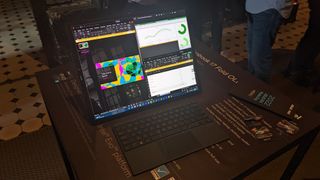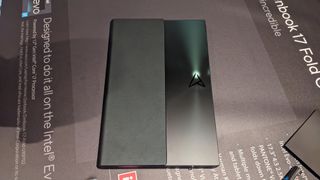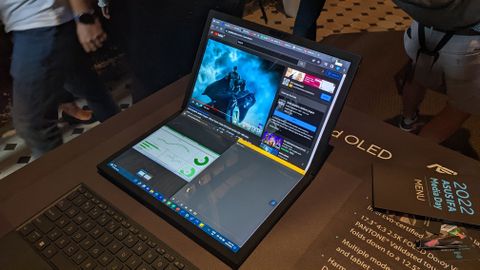Early Verdict
It’s a little on the heavy side, but the new foldable laptop from Asus is a flexible and robust piece of kit that feels futuristic yet still comfortably familiar. The price tag is a blow, however.
Pros
- +
Feels sturdy and durable
- +
OLED display is truly gorgeous
- +
Bluetooth keyboard feels good to use
Cons
- -
Seriously expensive
- -
Somewhat heavy
- -
No stylus support
Why you can trust TechRadar
Launching during IFA 2022 at a busy event at a stylish venue in Berlin, it’s not hard to see why everyone was excited to get their hands on the Asus Zenbook 17 Fold OLED. Foldable displays are nothing new; we’ve all seen folding phones by now, and Lenovo released a similar folding laptop over two years ago to a rather mixed reception.
We all know the technology isn’t quite there yet; we’re a long way from the slick ultra-slim folding screens seen in Westworld, after all. But there’s still something magical about the Zenbook 17 Fold OLED. It might not be the first of its breed, but it’s breaking new ground - this is the world’s first 17-inch foldable laptop display, making it the biggest bit of foldable tech you can reasonably use on a bus.
Asus was keen to drum up the innovation angle in our press briefing, and from the time we spent with the laptop, it certainly feels like a cutting-edge product. Asus worked closely with Intel to deliver the best possible product, running on a powerful 12th-generation Intel i7 processor. But innovation alone isn’t enough. Is it actually good? Let’s take a look.

Price and availability
With a starting price of $3,499 (£3,299), the Asus Zenbook 17 Fold OLED will likely have many would-be buyers folding their wallets shut. Sure, it’s easy to spend a stupid amount of money on a laptop these days, but at that price point you’re usually looking at a powerhouse gaming laptop with a high-end graphics card, which is absent in the 17 Fold OLED.
Still, we can’t say we’re overly surprised. This isn’t a mainstream product, and Asus isn't pretending that it is. Since this is new technology, the target audience isn’t entirely clear yet; tech enthusiasts, graphic designers, and fast-moving professionals are all within the scope of this laptop. There’s also currently only one configuration available, so there’s no option to pick a cheaper, lower-powered model.

Design
Fully unfolded, the Zenbook 17 Fold OLED feels like the world’s most luxurious tablet. The 17.3-inch display is incredibly bright and colorful, which will no doubt be a boon for artistic users. There’s a slight glossiness to the surface of the screen and tiny bumps over the hinge, since these folding panels must be made with thin plastic instead of glass.
Beyond simply using it as a ginormous tablet, the 17 Fold OLED has several different ‘modes’. Our personal favorite was what Asus refers to as ‘desktop mode’, which sees the display sit upright in landscape orientation using the rear kickstand with the nifty Bluetooth keyboard positioned in front of it. Then there’s the conventional ‘laptop mode’, in which the keyboard snaps to the deactivated bottom half of the folded screen to create a reasonable facsimile of a regular 12.5-inch laptop.
There are other, slightly more esoteric options too. You can remove the keyboard completely and use a smaller on-screen keyboard to add real estate while the laptop is folded, or half-fold it into a book-like orientation for reading. When you fold it shut, the keyboard can sit snugly between the two halves of the screen. The outer casing and hinge feel impressively durable; Asus revealed that thinner bezels were actually an option, but the designers opted for a still-respectable 89% screen-to-body ratio for better structural integrity.







Our very first thought upon picking up the Zenbook 17 Fold OLED was ‘oh, that’s heavy’. At 1.8kg (1.5kg without the keyboard), it’s undeniably weighty. But your perception of that weight will depend largely on how you use it; 1.8kg is almost ridiculously heavy for a 12.5-inch laptop, but the average 17-inch laptop weighs a lot more - Razer’s Blade 17 series weighs almost 3kg in comparison.
In terms of connectivity, we’re still on the cutting edge here. The only physical ports are a pair of Thunderbolt 4-enabled USB-C ports (which also serve for charging the laptop) and a headphone jack, but we’ve also got Wi-Fi 6E and Bluetooth 5.2, which have become near-mandatory for any high-end laptop.

Performance
Obviously, we don’t have full performance figures for the Zenbook 17 Fold OLED yet - you’ll be able to see those in our finished review, once we’ve had a chance to put it through its paces. We’re not sure what to expect when it comes to battery life, but we’d put our money on between six and seven hours.
Still, with an Intel Core i7-1250U CPU, 16GB of DDR5-5200 memory, and a terabyte of Gen4 PCIe SSD storage, we can expect reasonably good performance here. It’s not going to be well-suited to demanding tasks like 4K video editing, but it should prove to be a capable workhorse for most situations. In our brief testing period, we experimented with running multiple programs at once and shifting them around with the mode-switching features, and didn’t experience any noticeable slowdown.
One potential pitfall is the lack of stylus support here. With its beautiful screen and tablet modes, one could reasonably assume that the 17 Fold OLED would be a good pick for digital artists, but Asus stressed that using a hard-tip stylus could damage the bendable display panel. Soft-tipped capacitive styli are fine, apparently, but Asus has taken the safe option and dropped stylus support entirely, which is a shame.

Early verdict
We like the Asus Zenbook 17 Fold OLED - we like it a lot - but foldable tech is still a while off making it into the mainstream. Its painful price tag will be a barrier to entry for many, and the novelty factor won’t attract everyone.
But this has the potential to be a powerful productivity tool in the right hands, and we’re pleased to see Asus continue to push the envelope with innovative hardware that actually reaches the consumer, rather than a concept product that never actually makes it into mass production. We can’t wait to get one of these all to ourselves…
IFA 2022 is Europe's biggest tech show, and TechRadar is in Berlin to bring you all the breaking news and announcements, plus our hands-on first impressions of the new TVs, wearables, audio devices and other gadgets on show.

Christian is TechRadar’s UK-based Computing Editor. He came to us from Maximum PC magazine, where he fell in love with computer hardware and building PCs. He was a regular fixture amongst our freelance review team before making the jump to TechRadar, and can usually be found drooling over the latest high-end graphics card or gaming laptop before looking at his bank account balance and crying.
Christian is a keen campaigner for LGBTQ+ rights and the owner of a charming rescue dog named Lucy, having adopted her after he beat cancer in 2021. She keeps him fit and healthy through a combination of face-licking and long walks, and only occasionally barks at him to demand treats when he’s trying to work from home.
What is a hands on review?
Hands on reviews' are a journalist's first impressions of a piece of kit based on spending some time with it. It may be just a few moments, or a few hours. The important thing is we have been able to play with it ourselves and can give you some sense of what it's like to use, even if it's only an embryonic view. For more information, see TechRadar's Reviews Guarantee.

Nons SL660 review: an instant camera photographers will fall in love with

An incredible $100 billion bet to get rid of Nvidia dependence — tech experts reckon Microsoft will build a million-server strong data center that will primarily use critical inhouse components

The real total eclipse was better than the pics I shot with my iPhone 15 Pro Max and DSLR, and believe me I tried
